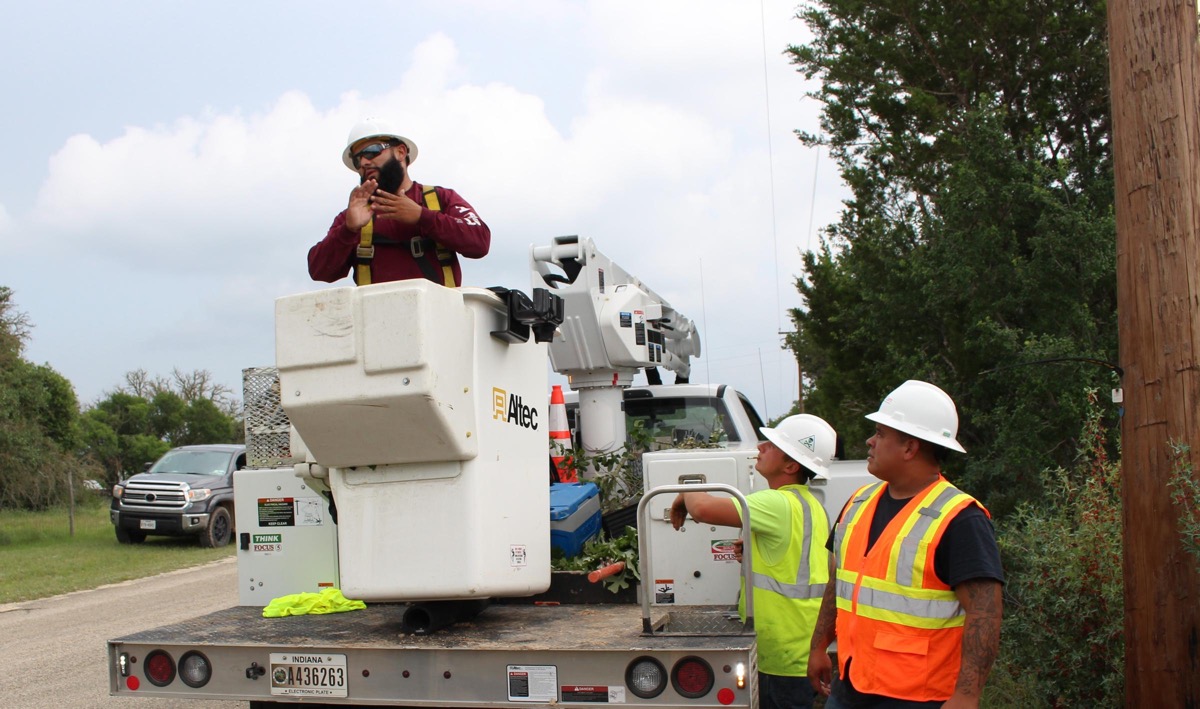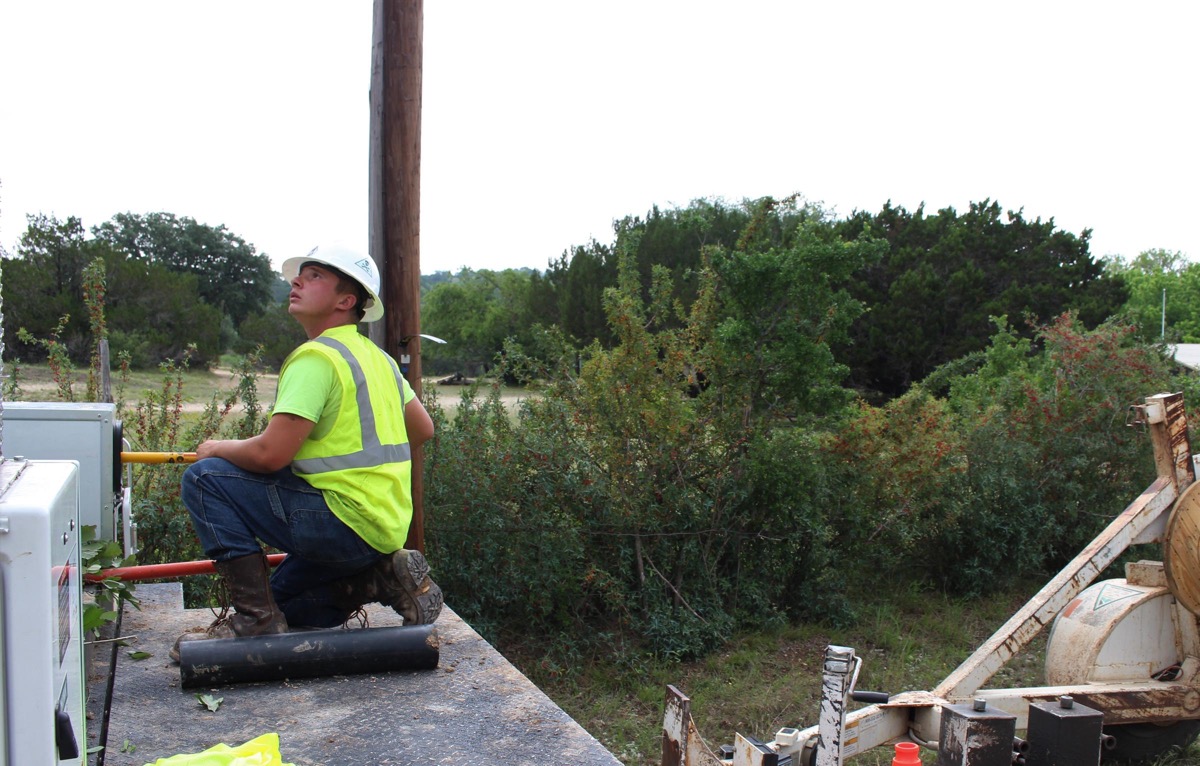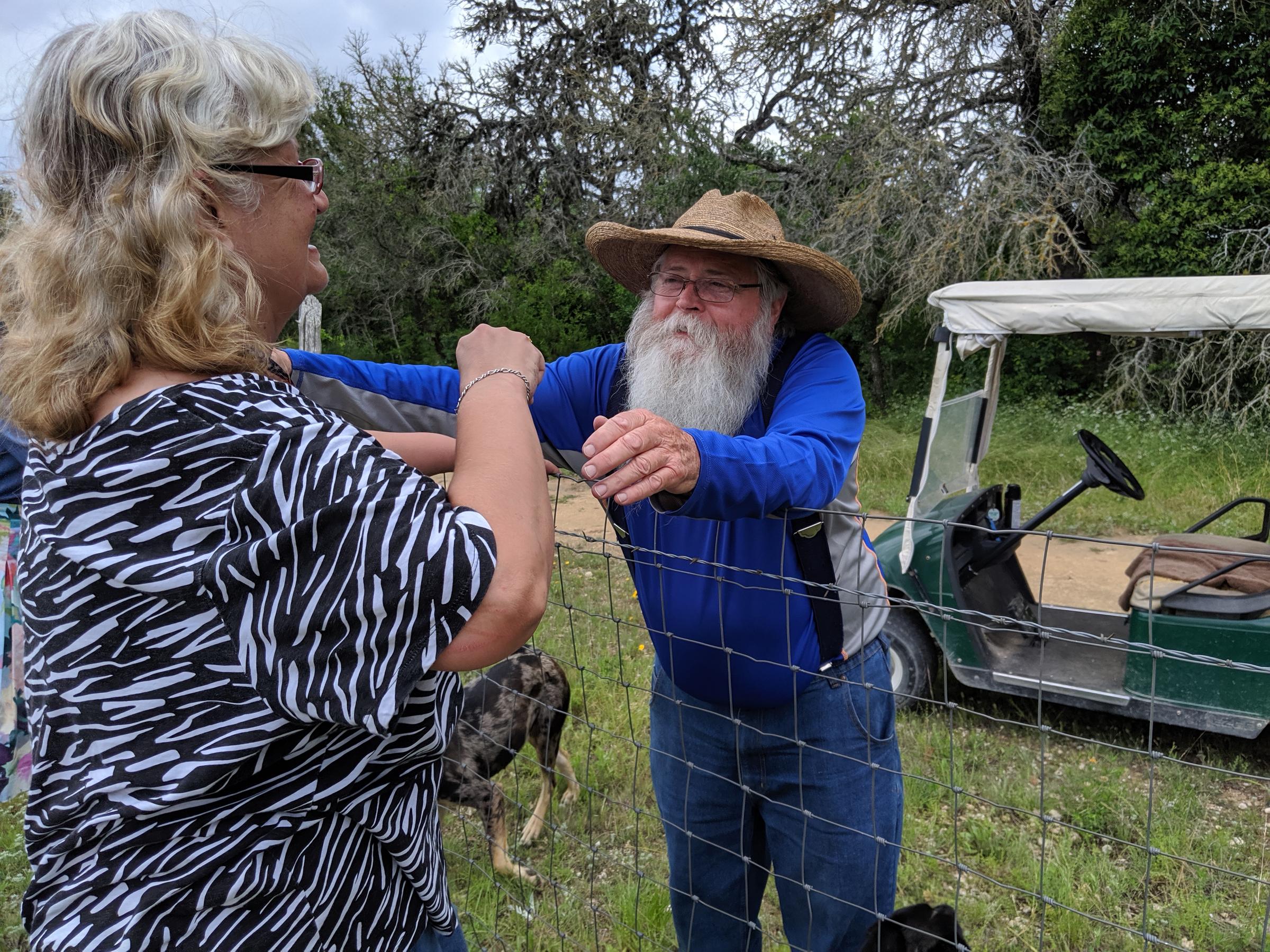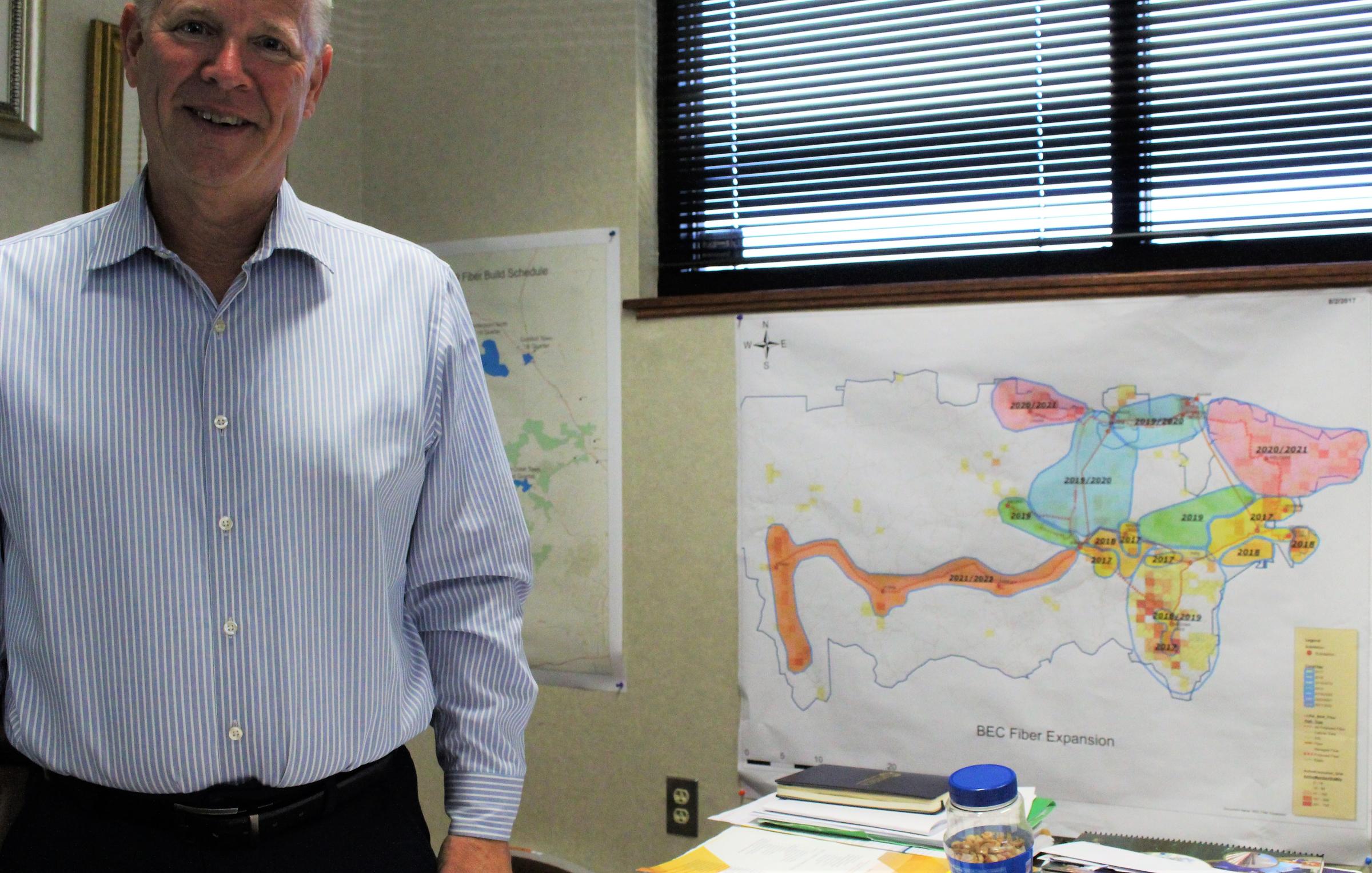Bridging The Digital Divide In Texas’ Wide-Open Spaces
11:38 minutes

 This segment is part of The State of Science, a series featuring science stories from public radio stations across the United States. This story, by Paul Flahive, originally appeared on Texas Public Media’s three-part series, “Connecting Rural Texas.”
This segment is part of The State of Science, a series featuring science stories from public radio stations across the United States. This story, by Paul Flahive, originally appeared on Texas Public Media’s three-part series, “Connecting Rural Texas.”
Some rural Texas communities are turning to an old playbook to connect the hundreds of thousands lacking access.
There are a myriad of reasons to bridge that digital divide, from slowing the brain drain in that area, to spurring innovation in farming and reinvigorating small town economies.
The same reasons advocates use to promote broadband today were used eighty years ago to push rural electrification.
“Because bringing electricity to rural areas was all about economic development and reaching the full potential of our economy,” said Jordana Barton, senior community development advisor for the Federal Reserve.
Going back to newsreel and films from that era, the barriers to both movements were also the same.
“But the power company says… say it costs too much. Say a lot of things,” said the farmer in a 1950s film funded by the Rural Electrification Administration. Like the power companies of the ’30s, internet service providers today have argued the cost of building infrastructure to sparsely populated regions isn’t profitable.
The same rural electric cooperatives—formed with federal loan dollars to reach millions of homes with electricity—are stepping in to take on broadband.
“Rural electric co-ops are a natural fit because they own poles and they own infrastructure. So it is cost-effective,” said Barton. She studies broadband internet access for the Federal Reserve, and she says co-ops can make a big impact because they already serve many of the people lacking service.
Since 2010, nearly 100 co-ops across the country have started serving hundreds of thousands of members with broadband internet.
On a quiet Hill Country road, a group of contractors for Bandera Electric Cooperative hang steel lashing wire on utility poles. The steel cable will later be paired with a fiber optic cable, carrying high-speed internet.
Jonathan Leyva was 15 feet in the air, standing in a hydraulic lift bucket. He pierced the wooden utility pole with pneumatic industrial drill. Thunder rumbled in the distance. He stopped and shouted down, “Mason, do you have your phone on you?”
“Can you check that radar and see how far rain is, lightning is away from us? I hear thunder, I just want to be safe about it,” he said.
He worried the steel cable could become a 20-mile long lightning rod.

Mason Boyer-Seufer, an apprentice lineman, stood below, also wearing a hard hat and neon green safety vest.
“I hope it doesn’t get rained out,” Mason said. They lost the whole day of work yesterday to weather. “Oh yeah, it was terrible. Raining cats and dogs.”
He took out his phone. The storm was going to miss them.
Bandera Electric is one of seven Texas electrical co-ops now providing broadband to its members. Taylor Electric in Abilene, Victoria Electric, Jackson Electric in Edna, Guadalupe Valley Electric in Gonzales and Tri-County Electric in Azle also provide broadband.
“I think it’s two or three poles down there. We can start there, or where Tony and his guys left off,” said Wes Haughton, staring down at construction sheets. He was trying to determine how far back they needed to hang the wire. Workers dragged the steel cable off a giant spool up the road. It ran out after an eighth of a mile.
Preceded by three excited dogs, retired San Antonio firefighter Larry Reed walked to his property line to watch the men work. He sported suspenders, a straw hat and a long white beard.
He was glad the storm was going to miss the area because he uses satellite internet.
“It works ok when the weather is perfectly clear, but when it rains—or we have any storms—it all shuts down,“ he said.
He said there aren’t any other internet options though, but he may go with Bandera Electric.

Bandera Electric has hung 500 miles of fiber optic cable on utility poles and another 250 miles to people’s homes.
“I’m not trying to be a telecom. What I want to do is provide to my electric members is a service that they don’t have,” said Bill Hetherington, CEO for Bandera Electric.
3200 co-op members have signed up, about 10 percent of their 30,000 members. It grew 200 percent last year, and they see it expanding quickly.
“You’re not doing this to make money. You’re doing this to allow your communities to survive and to be here 20 years from now,” Hetherington said.
Hetherington said the city of Bandera’s annual economic growth ticked up into double digits since BEC started providing the service two years ago. Other Texas electrical co-ops are paying attention.
“We get calls every week wanting to know how we made it work,” said Hetherington, who estimated they’ve interacted with around eight other co-ops. None have jumped into broadband yet.

Co-ops power homes for 4 million Texans—according to the statewide advocacy organization Texas Electric Cooperatives—but provide only around 30,000 with broadband, less than one percent.
“They’re not huge risk-takers,” said Mike Williams, CEO of Texas Electrical Cooperatives. He describes the members as older, and more fiscally conservative, who serve a population that is often lower income.
“There gonna make sure this makes sense before they do it,” he said.
In the last three years the numbers have been rising quickly though, and Williams is glad.
Co-ops that can make the economics work should move forward, or rural communities will continue to shrink.
“I frequently say to groups: You can’t sell or provide electricity to people who aren’t there anymore,” he said.
It may take more outside funding though to make those economics work though. Last year saw increased federal funds, including $600 million in loans and grants from the Department of Agriculture and more than $200 million from the FCC. But national leaders for America’s co-ops are calling for more. They want the FCC to move forward on a fund that could mean $20 billion over several years for rural broadband.
Like rural electrification, it will take years and money.
Unlike rural electrification, it is unclear how long the technology will last in the field. 5G wireless data is still largely untested in the field and requires dense placement, whereas some of the infrastructure placed 80 years ago is still in use.
But more people are taking up the issue. The U.S. Chamber of Commerce, AARP, USDA, FCC, along with Big Tech companies like Amazon and Microsoft. And increasingly rural communities are pushing lawmakers for the sake of their elderly parents who want to grow old at home and for their kids who can’t complete their studies at home.
“Well, there was a groundswell like this 80 years ago,” said Williams. “People in the country looked over the horizon at the city and saw lights, and modern conveniences, and said, ‘we want that.’”
Paul Flahive is the technology and entrepreneurship reporter for Texas Public Radio in San Antonio, Texas.
IRA FLATOW: This is Science Friday. I’m Ira Flatow coming to you today from the studios of Texas Public Radio in San Antonio. Later in the hour, a trip out to the giant gas giants, Jupiter and Saturn. But first, time to check in on the state of science.
SPEAKER 1: This is KERA news–
SPEAKER 2: For WWNO–
SPEAKER 3: St. Louis Public Radio.
SPEAKER 4: Iowa Public Radio News.
IRA FLATOW: Local science stories of national importance. And us being at Texas Public Radio in San Antonio, chances are you use some of the internet services each day all over Texas. Maybe you get your entertainment there. You communicate with friends and family, use it to buy things. You know, it is an ever-growing part of people’s lives and businesses.
But here in Texas, where everything is bigger, almost 2 million people are without access to high speed internet. And the size and wide open spaces of the state can make wiring rural communities something of let’s call it a challenge. Joining me to talk about it is Paul Flahive, technology and entrepreneurship reporter at Texas Public Radio. He’s here with me in San Antonio.
PAUL FLAHIVE: Thanks for having me.
IRA FLATOW: Thanks for having us here today. It’s nice to be here. So OK, let’s talk about how big the digital divide is. What’s the population of Texas and how much– what percentage of those people?
PAUL FLAHIVE: Yeah. So it’s about 28 million people in Texas, and around 2 million are without internet access or access to high speed internet. And they estimate about 80% of those are in rural areas.
IRA FLATOW: Where would rural areas be in Texas, for example?
PAUL FLAHIVE: Oh, well–
IRA FLATOW: All over the place.
PAUL FLAHIVE: Really, all over the place. I mean, there’s some big hubs, like Dallas Fort Worth, Houston, San Antonio, Austin. But all of West Texas, a lot of East Texas, once you get past Houston and north of Houston. So it’s a big swath of the state.
IRA FLATOW: So we might not really not know how many people the exact numbers are.
PAUL FLAHIVE: Yeah. Because of the way that the FCC collects data on who has access and who doesn’t, it’s ISP provided– so it’s the AT&Ts, the Verizons of the world tell us how many people they think have access. And it’s broken down by census blocks. So if one person in a census block has access, they say the whole census block has access.
So the estimates have been kind of widely discredited, and the FCC is trying to figure out a better way of collecting all that data. They just voted to change that last week.
IRA FLATOW: Hmm. And of course, everybody’s trying to figure out a better way of getting internet service then–
PAUL FLAHIVE: Absolutely.
IRA FLATOW: –to the rural areas. What’s the problem? From an outsider’s point of view, why don’t you just string some more cable and get everybody covered?
PAUL FLAHIVE: Absolutely. Well, you know, we rely on for-profit companies to make those things happen. And the equation just doesn’t work out in a lot of these communities when you’re talking about a service that has a lot of a cost associated with dragging a fiber optic cable along these poles, the people that own– getting the permission of property owners, things like that. And then providing a service for maybe a handful of people just doesn’t add up.
IRA FLATOW: So it’s a question of money. It’s always a question of money, right?
PAUL FLAHIVE: Often it is, yes.
IRA FLATOW: Because everybody has this private land. The whole state is private lands and no room for public access ways.
PAUL FLAHIVE: That’s right. There’s a lot of– a lot of Texas is private and getting the permission to cross people’s land has just recently changed for some of these rural cooperatives, electric cooperatives, so that they can actually get permission. They can just send out a notice, hey, we’re doing this. And only if a landowner– a landowner who may or may not be in the state– opts in or opts out do they have to worry about it.
IRA FLATOW: OK. Let’s talk about what we like to talk about, the technology fix.
PAUL FLAHIVE: Sure.
IRA FLATOW: Let’s put a satellite up. Oh, let’s wait for 5G. Put more towers in.
PAUL FLAHIVE: Absolutely. I think 5G has been talked about a lot. But 5G, especially in rural areas, is a real big question mark because 5G has to be a lot more densely populated. And they all connect to something. They all connect to a fiber cable. And if there’s no fiber cable, then there’s no 5G.
For satellites, you’re talking about the SpaceXs and Amazons and OneWeb of the world. They collectively want to put up tens of thousands of these broadband satellites. It’s unclear how fast they’ll be. There are some satellite options now but they’re pretty slow. That’s the complaints anyway.
IRA FLATOW: In your series, you reported on how, in many ways, this is like the drive to rural electrification in years past. And they accomplished that with rural co-ops.
PAUL FLAHIVE: That’s right.
IRA FLATOW: Tell us about that.
PAUL FLAHIVE: Yeah. So I mean, now, 80 years ago, in the 1930s, the federal government decided that it wanted to invest in electrifying these communities to give them options for running water powered by powering pumps that can run water, electric stoves, things like that.
And they thought that that was a worthwhile thing. They put money into these cooperatives so that local communities could run their own systems and they would be responsible for kind of making sure they were maintained as well just keeping them running.
And it seemed to work. And now, you’ve got those same rural cooperatives formed with federal loan dollars reaching millions of homes with electricity are stepping in to take on broadband in Texas. So I think there’s four million broadband user– four million electric co-op customers. And about 30,000 of them right now– so less than 1%– are broadband. But it’s growing.
IRA FLATOW: And you spoke with the head of one of these– I have a clip here– of these rural cooperatives about why they do this.
WILLIAM HETHERINGTON: It’s not about making money. You’re not doing this to make money. You’re doing this to allow your communities to survive and to be here 20 years from now.
PAUL FLAHIVE: Absolutely. That was Bill Hetherington, CEO of Bandera Electric Cooperative just northwest of San Antonio. And that’s how they talk about this. This is not something that is optional. This is something that has to happen if these communities are going to survive.
IRA FLATOW: And from the quote you played, they do feel like community spirit. It is not a money issue with them. It is something that, the future of the country is heading this way. We have to help out.
PAUL FLAHIVE: Yeah, absolutely. I think it’s something that people have it’s kind of become this mission for a lot of people.
And when it is your– I mean, he lives there. This is his community. So that’s kind of the beauty of the co-op model, is that there’s an incentive for them to do it. But also, it has to be approved by members and customers. So they have to decide to go into that business.
IRA FLATOW: And you talked about how 80 years ago, the cooperatives were formed to put electricity in. Today, you would never argue– today but 80 years ago, you would never argue, hey, who needs electricity? But today, internet service is about as needed, or people depend upon it as much as electricity was.
PAUL FLAHIVE: I think we’re at a moment in time where the idea of Internet and high speed internet as a luxury is over. It’s changing. And I think in those communities, they are demanding it. You talk to local economic development people as well as just city council people, and they’re getting asked, where’s the internet?
IRA FLATOW: So is the state– the state of Texas– putting money into this. Is the federal government putting money into this?
PAUL FLAHIVE: The feds have a lot of money tied up in this. $20 billion I think they just passed over 10 years last week for the rural opportunity fund. And then the state of Texas is not currently funding it with any legislative or grant funds. There was just a session and they didn’t pass any bills that had any money attached, but there are a couple.
IRA FLATOW: But it would seem that in certain places you could not survive. I mean, physically and communally. Like, let’s say, for example, hospitals. Don’t hospitals have to be wired to the internet?
PAUL FLAHIVE: Yeah. There’s a big question right now about hospitals. And there are programs that specifically target libraries and schools and critical places like hospitals that try and get them funding so that it’ll bring down the cost of high speed internet to these places. But in Texas, I think we’ve lost about 23, 24 hospitals in just the last five years in rural communities, which is– often, the thing that they say is going to replace that when we talk about rural communities and aging in place is telehealth. But a lot of places don’t have the infrastructure.
IRA FLATOW: If you can’t get to your doctor or you live in a rural community, you may be able to send your symptoms in by telephone or by the internet. But if you don’t have that internet connection–
PAUL FLAHIVE: Yeah. If it’s not reliable– you know, in the course of doing some of this reporting, there was at least one couple in Corrigan, Texas I talked to that were lamenting just how unreliable their internet connection was and how even just a basic doctor’s appointment requires you to log in and write and sign up for a slot.
IRA FLATOW: You know, we’ve heard about the digital divide in the rest of the country between have and have not schools. So this would also be affecting schoolchildren learning how to become fluent in coding or the internet also. You’re going to have a section that cannot do that.
PAUL FLAHIVE: Absolutely. I don’t have any hard data on how that impacts them, but you do hear from basically every one– every one of the communities I’ve visited to talk about this, at least one person will bring up the fact that kids are hanging out in the parking lot of the library after it closes to get access to Wi-Fi. They’re going to McDonald’s not for the burgers but for the free Wi-Fi access.
IRA FLATOW: Is it becoming a political issue at all, or is it still something on the peripheral?
PAUL FLAHIVE: I mean, it’s hard to say if it’s becoming like a political issue. Obviously, it’s not something people are running on in Texas. But we just saw the Warren campaign publish a big broadband plan that allotted $85 billion in grants for this issue, as well as would preempt a lot of states laws that prevent them from having municipal broadband.
IRA FLATOW: So if you think that the Democrats may think that Texas is in play during this presidential election, they might come and use this as an issue.
PAUL FLAHIVE: It might be. I mean, I think having those conversations, with the Warren campaign being the first, it may very well be that they push a lot of other communities and other leaders to start introducing this kind of legislation.
IRA FLATOW: And as far as the long-term outlook, does anybody believe that sooner or later this is not going to come out to the rural neighborhoods?
PAUL FLAHIVE: I mean, it’s hard to say that it’s inevitable. I think there’s a lot of people working on it, and I think I’ve never kind of seen it get as talked about as it is now and just in the last 18 months. So I think we are at a special moment in time where everyone is sort of paying attention to this. And even banks have a stake in this with wanting to reduce their brick and mortar shops and being able to invest in these programs with the Federal Reserve CRA stuff.
So yeah, I think there’s a lot of interest. And it’s hard to say, though, whether or not it’s going to absolutely happen.
IRA FLATOW: Yeah. Do people say, hey, you know, you choose to live out there on the ranches and the far places. Heck with you.
PAUL FLAHIVE: I’m sure they do. And that’s one of the big things. That’s one of the big draws of living in these communities, is they don’t have some of these things that– the traffic and the things of the cities. But that’s what– we’re already at a point where these communities realize that people are passing on their towns– living in them, locating businesses in them– because they don’t have high speed internet.
IRA FLATOW: Yeah. It’s quite interesting. Thank you for taking time to be with us. This is really interesting topic, Paul.
PAUL FLAHIVE: Thanks so much.
IRA FLATOW: Paul Flahive, technology and entrepreneurship reporter at Texas Public Radio.
Copyright © 2019 Science Friday Initiative. All rights reserved. Science Friday transcripts are produced on a tight deadline by 3Play Media. Fidelity to the original aired/published audio or video file might vary, and text might be updated or amended in the future. For the authoritative record of Science Friday’s programming, please visit the original aired/published recording. For terms of use and more information, visit our policies pages at http://www.sciencefriday.com/about/policies/
As Science Friday’s director and senior producer, Charles Bergquist channels the chaos of a live production studio into something sounding like a radio program. Favorite topics include planetary sciences, chemistry, materials, and shiny things with blinking lights.
Ira Flatow is the founder and host of Science Friday. His green thumb has revived many an office plant at death’s door.